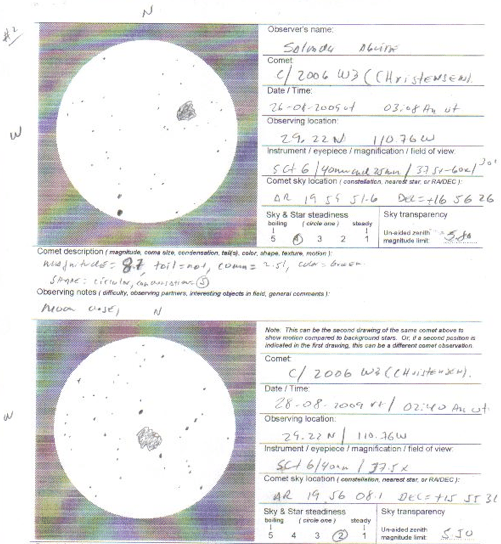The brightest comet in the sky is Comet C/2006 W3 (Christensen). Now is the best time to observe this comet as it is nicely located in the evening sky after the end of twilight. At 8th magnitude the comet is not bright enough to be seen with just the naked eye. It will require a small telescope, though observers at very dark sites can probably see the comet with small binoculars. Though the comet will be observable over the next month or three, it is slowly fading and getting lower in the sky.
Moving through the constellation Aquila, the comet is located near the meridian, or due south, at the end of evening twilight. It is a few degrees to the southwest of Altair, the brightest star in Aquila and the southernmost star in the Summer Triangle. The comet is equally visible from both the northern and southern hemispheres. Recent observations put the comet near magnitude 8.5. It’s brightness should remain fairly steady for the rest of the month.
Ephemerides for the comet can be found at the Minor Planet Center.
Another version of its sky chart can be found at Comet Chasing.

The comet was discovered by Eric Christensen of the Catalina Sky Survey on 2006 November 18. He used the 0.68-m Catalina Schmidt telescope located near Mount Bigelow in the Catalina Mountains north of Tucson. It was the 15th of Eric’s 19 comet discoveries. At discovery the comet was located 8.00 AU from Earth and 8.66 AU from the Sun which is almost as far from the Sun as Saturn (9.8 AU). Though such a large discovery distance is not rare these days it is still impressive since only a small fraction of all comets are discovered out that far.
Eric shared some thoughts on his discovery: “Regarding C/2006 W3, I honestly can’t recall much about its discovery. Perhaps the only remarkable thing about it was that it was so unremarkable at the time: small, faint, diffuse, and without any obvious tail or structure. When the initial MPEC came out I remember being excited by how distant it was and how close it was predicted to come (q~1.5), though this of course was quickly modified to a “disappointing” q~3.1.
It’s a little ironic that less than 6 months after discovery, I had moved to the southern hemisphere where C/2006 W3 would remain hidden from view until pretty recently. I’m embarrassed to admit that I haven’t yet seen it visually through even a small telescope…and unfortunately there’s no eyepiece on Gemini. ;)”
As Eric mentioned, right after discovery the original orbit had the comet coming much closer to the Sun at perihelion. After a week or 2 of further observations the perihelion distance was moved farther away. This is common with distant comets. It’s not that the orbit is actually changing but rather that we don’t have sufficient observations to accurately determine the orbit. In the movies, the astronomer discovers something and then after a few furious seconds of keystrokes knows exactly where the object is going. In real life it may take hours (for very close objects) to years (for objects out by Pluto) of additional observations to nail down the correct orbit.
Comet Christensen is a long-period comet taking ~100,000 years or more to orbit the Sun. Closest approach to the Sun (perihelion) occurred on 2009 July 6 at 3.13 AU from the Sun. The comet’s orbit is highly inclined to the plane of the solar system at an angle of 127° which is slightly retrograde (meaning it orbits in the opposite direction as the planets).

Back in May of this year I was able to observe Comet Christensen with the 61″ telescope near Mount Bigelow (located at the same site as the Catalina Schmidt telescope that was used to discover the comet). At the time the comet was roughly the same brightness as it is now. Processing the image to look for structure in the inner coma revealed a few jets (the insert image in the figure below). This is somewhat surprising for such a distant comet. Usually only comets that are much closer to the Sun display jet activity.

For another view of the comet, Salvador Aguirre of Hermosillo, Mexico submitted drawings of the comet as seen through his small backyard telescope. As his drawings show the comet does not have much of a tail and looks like a small faint smudge on the sky.

I’d like to thank Eric for sending his recollections and Salvador for sending his observations.
If anyone has pictures or drawings of this or any other comet to share, I’d like to post them.

